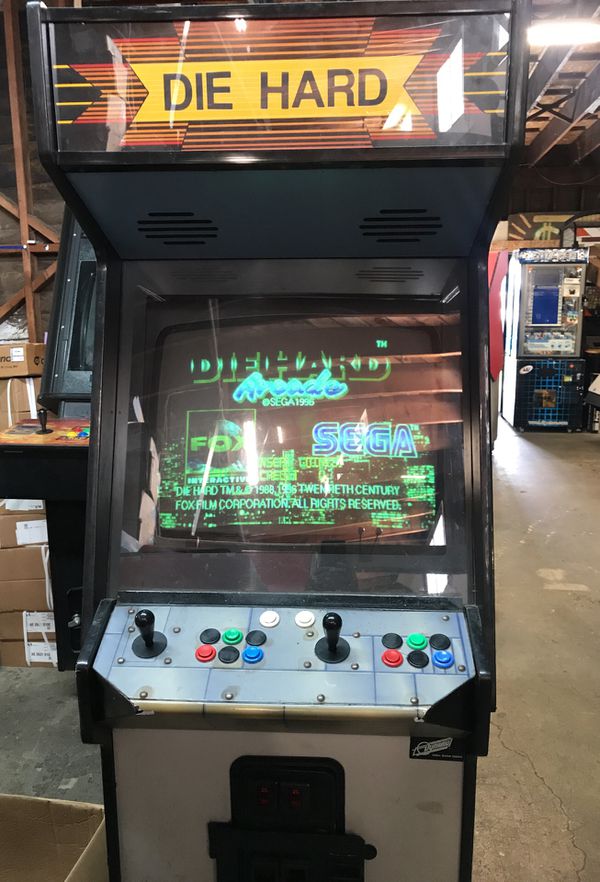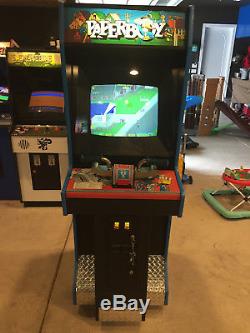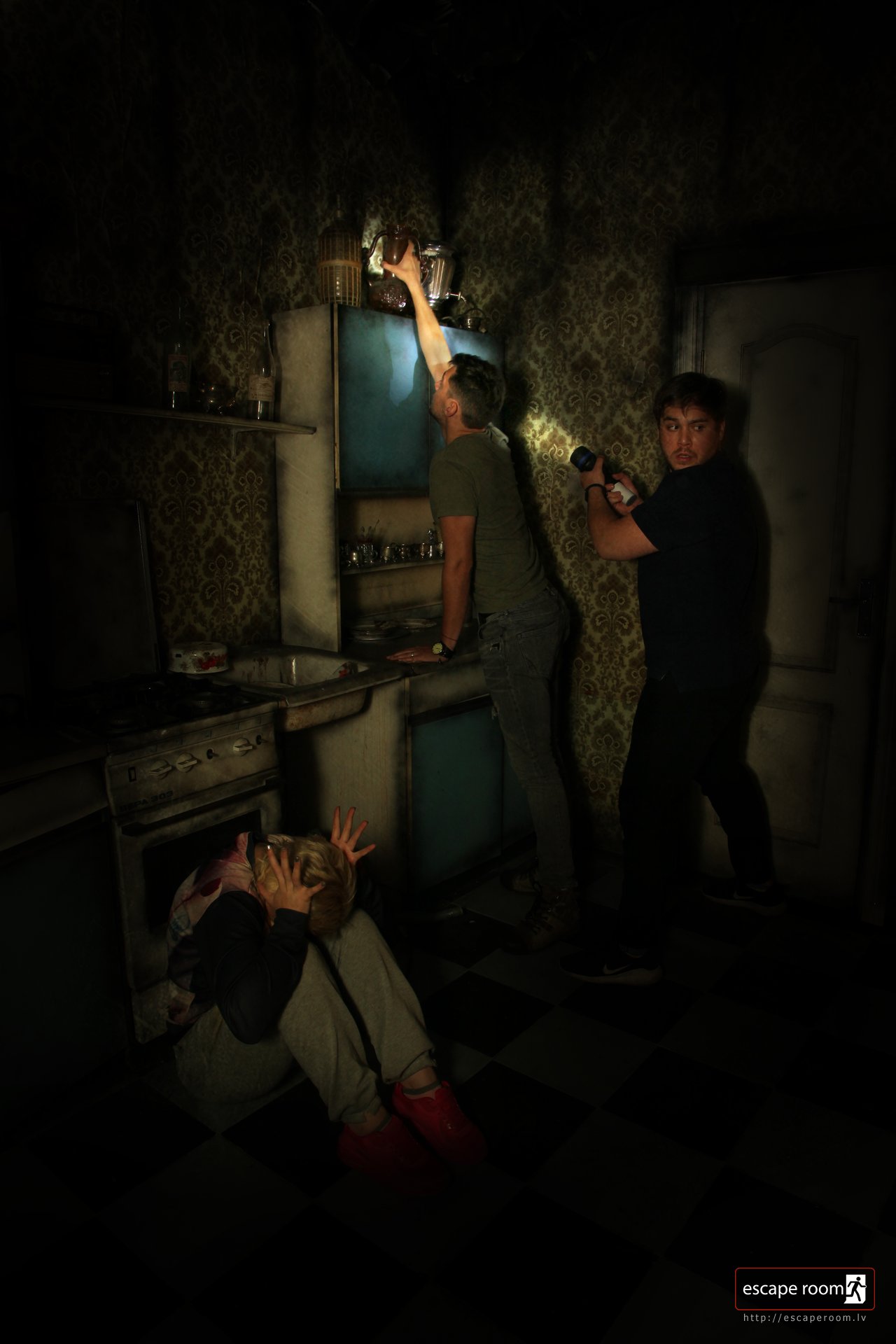- Description of Die Hard Arcade - MAME. This game Die Hard Arcade - MAME working perfectly with emulator version mame64ui, you can download on this web site.
- Die Hard Arcade, known in Japan as Dynamite Deka (ダイナマイト刑事, Dainamaito Deka, lit. Dynamite Detective) is a beat 'em up video game released by Sega.
Die Hard Arcade, known in Japan as Dynamite Deka (ダイナマイト刑事 Dainamaito Deka) is an beat 'em up arcade game released by Sega. An original property in Japan, th.
| Die Hard Trilogy | |
|---|---|
| Developer(s) | Probe Entertainment |
| Publisher(s) | Fox Interactive Electronic Arts Victor (Japan, PS1) Sega (Japan, Sega Saturn) |
| Platform(s) | PlayStation, Microsoft Windows, Sega Saturn |
| Release | PlayStation
|
| Genre(s) | Third-person shooter, light gun shooter, driving game |
| Mode(s) | Single-player |
Die Hard Trilogy is a video game based on the first three installments of the Die Hard series of action movies. Die Hard Trilogy features three games in one, each based on a movie installment and featuring a different genre and gameplay style. The game was well received and would eventually become a PlayStation Greatest Hits and PlayStation Platinum game. Die Hard Trilogy also inspired a sequel entitled Die Hard Trilogy 2: Viva Las Vegas. The sequel retained the three different playing styles, but featured a spin-off storyline that was not connected to the movie series.
Gameplay[edit]
Die Hard[edit]
Die Hard is a third-person shooter. The player battles terrorists and rescues hostages in the Nakatomi Plaza, which is the setting of the first film in the series.[2]

Die Hard 2: Die Harder[edit]
Die Hard 2: Die Harder is presented as an on rails-shooter, where the player must stop terrorists who have taken over Dulles Airport from the second film.
Players control the crosshair with a gamepad, light gun, or mouse. Die Hard Trilogy was one of the few light gun games available for the PlayStation that was not compatible with Namco's GunCon/G-Con 45 controller or GunCon 2.[citation needed] However, it was compatible with Sega's Stunner light gun for the Saturn version.[2]
Die Hard with a Vengeance[edit]
In Die Hard with a Vengeance, the player goes on a joyride driving a taxicab, sports car, and dump truck throughout all of New York City and is tasked with finding and defusing several explosives before they can go off.
Development[edit]
The game was developed by a UK-based development studio, Probe Entertainment. The Die Hard with a Vengeance segment was developed first and was intended to be a standalone release, but publisher Fox Interactive insisted that the game should be more closely linked to the films, leading Probe to develop the other two segments.[3] Initially the Die Hard 2 segment of the game was developed with polygonal enemies,[4] but they were later replaced with digitized sprites. For the Die Hard with a Vengeance segment, the team had wanted to use an authentic recreation of New York City, but found that when driving at 200 miles per hour, an accurate model of NYC felt too small and confining.[5]
The PlayStation was chosen as the lead platform because lead programmer Simon Pick strongly felt that it was the most powerful format of the time. In particular, he reasoned that the Saturn and PC versions would come out better if the programmers were trying to emulate impressive graphical effects on an extant PlayStation version than if they were designing the game around the hardware limitations of the Saturn.[5] Pick elaborated on how the team intended to optimize the game for Saturn:
At the moment on PlayStation, we've got six or seven circular images which appear to make the lens flare effect, but maybe we'll just have two or three on Saturn version to keep the frame rate up. ... Frame rate is the main thing. We've got one guy coming over to us from Sega who's very clever. He's written a program which basically takes a polygonal model, and as it's rendering it looks at the size of the polygons; if they're very small it says 'there's no point texturing this, let's do it flat in just one color,' and this way it saves processor time and helps keep the frame rate up. We're going to reduce the detail of the models quite a lot, and reduce the texturing so the roads on Saturn will probably be flat shaded - so it's like a gray road rather than having textures.[5]
Reception[edit]
| Reception | ||||||||||||||||
|---|---|---|---|---|---|---|---|---|---|---|---|---|---|---|---|---|
| ||||||||||||||||
Die Hard Trilogy was a commercial hit, with sales above 2 million units by March 2000.[13]
The PlayStation version was positively reviewed. As of June 2017, it holds an 86% ranking at GameRankings.[14] Most critics considered the high value-for-money of getting three games in one to be Die Hard Trilogy's strongest point.[6][7][10][11] A few even stated that none of the three component games were good enough to stand on their own, but the variety offered by the collection as a whole makes it exceptionally entertaining.[6][10] However, the majority commented that all three component games are outstanding even on their own terms.[6][7][9][11]GamePro's Scary Larry presented a dissenting opinion; while he highly praised the game's addictive quality and sound effects, he argued that the three segments are ultimately just rehashes of (respectively) Resident Evil, Virtua Cop, and Twisted Metal.[15] The most common criticism was that the Die Harder segment requires the Konami light gun to be enjoyable, since the cursor when using the standard controller is slow and difficult to move.[6][15][10] The first segment of the game was particularly praised for its deep challenge, requiring players to out-think the enemy.[7][10][9]
Die Hard Trilogy was a finalist for the Computer Game Developers Conference's 1996 'Best Adaptation of Linear Media' Spotlight Award,[16] but lost the prize to I Have No Mouth, and I Must Scream.[17] However, Electronic Gaming Monthly editors named it Action Game of the Year.[18]
The Saturn port also received mostly positive reviews, though it was often compared unfavorably to the PlayStation original. GamePro's The Rookie said the graphics are not as sharp as the PlayStation version's, especially in the Die Harder segment, but the gameplay is addictive enough to make this relatively unimportant.[19] Josh Smith stated in GameSpot that the sluggish controls and poor graphics, especially as compared to the PlayStation version, make the first two segments of the game nearly unplayable, since lining up shots in time is awkward and frustrating. However, he said that in the third segment the animation is actually better than the PlayStation version's, and that the fast pace and black humor of this segment make it worth buying Die Hard Trilogy all by itself.[8] Paul Glancey of Sega Saturn Magazine summarized, 'Often when you see compilations like this there's ... one section that stands out as the one that the programmers thought of first and lavished the most attention on, but all three sections of Die Hard Trilogy have their fair share of thrills, great visuals and clever ideas.'[12]
In Germany, the game was banned because of its extreme violence, especially being able to drive through harmless people with blood spilling all over the windshield.[citation needed]
References[edit]
- ^'Christmas Games Guide'. Computer Trade Weekly. No. 616. United Kingdom. 2 December 1996. p. 43.
- ^ abFulljames, Stephen (February 1997). 'Yippeeeee-kai-ay, Muddy Funsters!'. Sega Saturn Magazine. No. 16. Emap International Limited. pp. 54–57.
- ^'To Die For'. Sega Saturn Magazine. No. 7. Emap International Limited. May 1996. pp. 50–55.
- ^'Die-Hard with a Saturn! Die Hard Trilogy'. Sega Saturn Magazine. No. 5. Emap International Limited. March 1996. p. 10.
- ^ abc'Die Hard Trilogy'. Next Generation. No. 17. Imagine Media. May 1996. p. 84.
- ^ abcde'Review Crew: Die Hard Trilogy'. Electronic Gaming Monthly. No. 86. Ziff Davis. September 1996. p. 26.
- ^ abcdSterbakov, Hugh (December 1, 1996). 'Die Hard Trilogy Review'. GameSpot. Retrieved 5 June 2017.
- ^ abSmith, Josh (January 14, 1997). 'Die Hard Trilogy Review'. GameSpot. Retrieved 20 March 2018.
- ^ abc'Die Hard Trilogy'. IGN. November 21, 1996. Retrieved 5 June 2017.
- ^ abcde'Stayin' Alive'. Next Generation. No. 23. Imagine Media. November 1996. p. 268.
- ^ abcPSM 10
- ^ abGlancey, Paul (March 1997). 'Review: Die Hard Trilogy'. Sega Saturn Magazine. No. 17. Emap International Limited. pp. 68–69.
- ^https://web.archive.org/web/20020302155411/http://www.gamespot-es.com/news/00_03/01/2/INDEX.ASP
- ^Die Hard Trilogy for PlayStation - GameRankings
- ^ ab'ProReview: Die Hard Trilogy'. GamePro. No. 93. IDG. June 1996. p. 54.
- ^Staff (April 15, 1997). 'And the Nominees Are...'Next Generation. Archived from the original on June 5, 1997. Retrieved July 25, 2019.
- ^'Spotlight Awards Winners Announced for Best Computer Games of 1996' (Press release). Santa Clara, California: Game Developers Conference. April 28, 1997. Archived from the original on July 3, 2011.
- ^'The Best of '96'. Electronic Gaming Monthly. No. 92. Ziff Davis. March 1997. p. 88.
- ^'Saturn ProReview: Die Hard Trilogy'. GamePro. No. 103. IDG. April 1997. p. 87.
External links[edit]
- Die Hard Trilogy at MobyGames
| Die Hard Arcade | |
|---|---|
| 250px | |
| Basic Information | |
| Video Game | |
| Wow Entertainment, Sega Technical Institute | |
| SEGA, Fox Interactive | |
| Beat 'em up | |
| CD-ROM | |
| Arcade, Saturn and PlayStation 2 | |
| Retail Features | |
| Ratings | |
| Main Credits | |
| Robert Steele, Kunitake Aoki, Tatsuto Kumada | |
| Makoto Uchida | |
| Roger Hector, Rikiya Nakagawa, Makoto Uchida | |
| Makoto Uchida | |
| Howard Drossin | |
| North American Release Date(s) | |
| Arcade machines 1996 Saturn April 8, 1997 PlayStation 2 April 27, 2006 | |
| Awards | Changelog | Cheats | Codes Codex | Compatibility | Covers | Credits | DLC | Help Localization | Manifest | Modding | Patches | Ratings Reviews | Screenshots | Soundtrack Videos | Walkthrough | |
| Achievements GOG | In-Game | Origin | PlayStation Trophies | Retro Steam | Xbox Live | |
Die Hard Arcade is the licensed North American, European and Australian version of the Japanese videogameDynamite Deka (ダイナマイト刑事?). The game is a beat 'em up with loose ties to the Die Hard movie series of the same name.
However, other than the title, the building and the fact that the hero (named Bruno Delinger in the Japanese version) resembled John McClane, the game and the movie have little to do with each other (in fact, the license was purchased when the game was essentially complete for the American and European releases). It is a 1 or 2 player game in which the male and/or female characters fight through action-packed levels to save the President's daughter from a band of terrorists.
Gameplay[edit | edit source]
The game sees players fighting their way through waves of enemies, using their fists, feet, and a variety of weapons, from household items such as brooms to high-damage anti-tank cannons. Players progress through the requisite enemies and bosses with cut scenes interspersed into the action. Various cut scenes in the game contain Quick Time Event sequences, in which the player must press a particular button within a short time limit to alter the impending scene e.g., defeating an enemy or group of enemies in the sequence so that the player will not have to then engage them in combat.
At the end of the game if both players are still alive, the gameplay will change to that of a fighting game, where the two players will fight each other on the rooftop of the skyscraper to gain the sole appreciation of the President's daughter.
The game also features an emulated port of Sega's 1979 arcade game Deep Scan, which can be used to gain extra credits.
Development[edit | edit source]

The game was created by Sega, using a team up of the successful Japanese AM1 (Arcade Machine 1, also known as WoW Entertainment) group and the US-based Sega Technical Institute (STI), which developed in collaboration with Sonic Team some of the Sonic the Hedgehog series of games following the original, to create this game. AM1 provided the engineering, and some of the design and art, and STI provided art, design and animation. Incidentally, Die Hard Arcade was also the final game developed by STI before the studio was dissolved.
The game was created simultaneously for the Titan Arcade system and Sega Saturn but the home version was released later.
The Japanese version of Die Hard Arcade, Dynamite Deka, was followed by a sequel titled Dynamite Deka 2 for the arcade and Dreamcast. The sequel was released internationally as Dynamite Cop. As with Dynamite Deka's resemblance to the movie, Die Hard, Dynamite Cop bore a striking similarity to the film, Speed 2: Cruise Control.
See also[edit | edit source]

- Sega Ages - The line Die Hard Arcade was re-released on PS2 under
Die Hard Arcade Game Emulator
External links[edit | edit source]
- Die Hard Arcade at Museum of the Game
fr:Die Hard Arcade